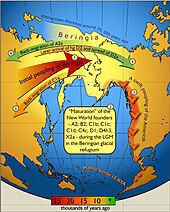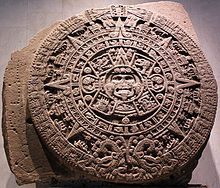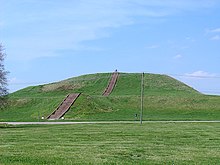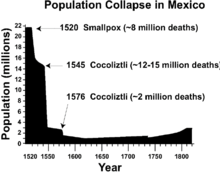US History/Pre-Columbian

Human civilization in the Americas probably began in the last ice age, when prehistoric hunters crossed a land bridge between the Asian and North American continents.[1] Civilizations in North America, Central America, and South America had different levels of complexity, technology, and cohesiveness.
Some of the most powerful and organized societies occurred in South and Central America. These cultures developed writing, allowing them to spread and dominate. They created some of the largest cities in the Ancient world.
North American cultures were more fragmented and less unified. The tribe was often the major social unit, with exchanges between tribes creating similar societies over vast distances. Tribal dwellings as large as European towns flourished in the rugged desert of southwestern North America.
European-descended historians have difficulty referring to these cultures as a whole, as the native people did not have a unified name for themselves. At first, Europeans called natives "Indians". This term came from the belief by Christopher Columbus that he had discovered a new passage to India.[2] Despite Amerigo Vespucci ascertaining that the Americas were not actually India, Indian continued to be used as the 'de facto' name for native inhabitants until around 1960.[2] Starting in the 1960s, the term "Native American" was used. Yet this term may be too problematic: The name America derives from Amerigo Vespucci, an Italian who had little to do with the native people.[2] There is also "American Indian". This is too general a term for a group having little in common other than skin tone and non-European language. In Canada, the term "First People" is used. All these terms for the native people of America show just how diverse Pre-Columbian America was and the disagreement continues among scholars today about this period.
Early Inhabitants of the Americas[edit | edit source]
Bering Land Bridge[edit | edit source]

American history does not begin with Columbus's 1492 arrival. The Americas were settled long before the first European arrived.[3] Civilization began during the last ice age, some 15 to 40 thousand years ago.[3] Huge ice sheets covered the north, so sea levels were much lower, creating a land bridge between Asia and North America.[3] This was the Bering land bridge, a gap in two large ice sheets creating a connection from lands near present day Alaska, through Alberta, and into the continental United States.[3]
Nomadic Asians following herds of wild game traveled into the continental United States. A characteristic arrow point was found and first described near the present day town of Clovis, NM. Specialized tools and common burial practices are seen in many archaeological sites through North America and into South America.
Clovis People[edit | edit source]
The Clovis people are one of North America's earliest civilizations. It is not clear if the finds represent one unified tribe, or many tribes with a common technology and belief. Their trek across 2000 rugged miles is one of the great feats of pre-history. Their culture disappears dramatically from the archaeological record 12,900 years ago, with widespread speculation about what caused their disappearance. Theories range from the extinction of the mammoth, to sudden environmental changes caused by a comet, to flooding caused by the break of a massive freshwater lake, Lake Agassiz.
There is controversy about Pre-Clovis settlement of North and South America. Comparisons of culture and linguistics offer evidence of the influence of early America by several different contemporary cultures. Some genetic and time-dating studies point to the possibility that ancient Americans came from other places and arrived earlier than at the Clovis sites in North America. Perhaps some ancient settlers to the hemisphere traveled by boat along the seashore, or arrived by boats from the Polynesian islands.
As time went on, many of these first settlers settled down into agricultural societies, complete with domesticated animals. Groups of people formed stable tribes and developed distinct languages of their own, to the point that more distant relatives could no longer understand them. Comparative linguistics -- the study of languages of different tribes -- shows fascinating diversity, with similarities between tribes hundreds of miles apart, yet startling differences with neighboring groups.
At times, tribes would gain regional importance and dominate large areas of America. Empires rose across the Americas that rivaled the greatest ones in Europe. For their time, some of these empires were highly advanced.
Early Empires of Mesoamerica[edit | edit source]
Meso-American civilizations are among some of the most powerful and advanced civilizations of the ancient world. Reading and writing were widespread throughout Meso-America, and these civilizations achieved impressive political, artistic, scientific, agricultural, and architectural accomplishments. Many of these civilizations gathered the political and technological resources to build some of the largest, most ornate, and highly populated cities in the ancient world.
Maya[edit | edit source]

The aboriginal Americans settled in the Yucatan peninsulas of present-day Mexico around 10,000 BCE. By 2000 BCE, the Mayan culture had evolved into a complex civilization. The Mayans developed a strong political, artistic and religious identity among the highly populated Yucatan lowlands. The classic period (250-900 CE) witnessed a rapid growth of the Mayan culture and it gained dominance within the region and influence throughout present-day Mexico. Large, independent city-states were founded and became the political, religious, and cultural centers for the Mayan people.
Mayan society was unified not by politics, but by their complex and highly-developed religion. Mayan religion was astrologically based, and supported by careful observations of the sky. The Mayans had a strong grasp of astronomy that rivaled, and, in many ways, exceeded that of concurrent European societies. They developed a very sophisticated system for measuring time, and had a great awareness of the movements in the nighttime sky. Particular significance was attached to the planet Venus, which was particularly bright and appeared in both the late evening and early morning sky.
Mayan art is also considered one of the most sophisticated and beautiful of the ancient New World.
The Mayan culture saw a decline during the 8th and 9th century. Although its causes are still the subject of intense scientific speculation, archaeologists see a definite cessation of inscriptions and architectural construction. The Mayan culture continued as a regional power until its discovery by Spanish conquistadors. In fact, an independent, non-centralized government allowed the Mayans to strongly resist the Spanish conquest of present-day Mexico. Mayan culture is preserved today throughout the Yucatan, although many of the inscriptions have been lost.
Aztec[edit | edit source]

The Aztec culture began with the migration of the Mexica people to present-day central Mexico. The leaders of this group of people created an alliance with the dominant tribes forming the Aztec triple alliance, and created an empire that influenced much of present-day Mexico.
The Aztec confederacy began a campaign of conquest and assimilation. Outlying lands were inducted into the empire and became part of the complex Aztec society. Local leaders could gain prestige by adopting and adding to the culture of the Aztec civilization. The Aztecs, in turn, adopted cultural, artistic, and astronomical innovations from its conquered people.
The heart of Aztec power was economic unity. Conquered lands paid tribute to the capital city Tenochtitlan, the present-day site of Mexico City. Rich in tribute, this capital grew in influence, size, and population. When the Spanish arrived in 1521, it was the fourth largest city in the world (including the once independent city Tlatelolco, which was by then a residential suburb) with an estimated population of 212,500 people. It contained the massive Temple de Mayo (a twin-towered pyramid 197 feet tall), 45 public buildings, a palace, two zoos, a botanical garden, and many houses. Surrounding the city and floating on the shallow flats of Lake Texcoco were enormous chinampas -- floating garden beds that fed the many thousands of residents of Tenochtitlan.
While many Meso-American civilizations practiced human sacrifice, none performed it to the scale of the Aztecs. To the Aztecs, human sacrifice was a necessary appeasement to the gods. According to their own records, one of the largest slaughters ever performed happened when the great pyramid of Tenochtitlan was reconsecrated in 1487. The Aztecs reported that they had sacrificed 84,400 prisoners over the course of four days.
With their arrival at Tenochtitlan, the Spanish would be the downfall of Aztec culture. Although shocked and impressed by the scale of Tenochtitlan, the display of massive human sacrifice offended European sensitivity, and the abundant displays of gold and silver inflamed their greed. The Spanish killed the reigning ruler, Montezuma in June 1520 and lay siege to the city, destroying it in 1521, aided by their alliance with a competing tribe, the Tlaxcala.
Inca[edit | edit source]

With the ascension of Manco Capac to emperor of a tribe in the Cuzco area of what is modern-day Peru around 1200 BCE, the Incan civilization emerged as the largest Pre-Columbian empire in the Americas.
Religion was significant in Inca life. The royal family were believed to be descendants of the Inca Sun God. Thus, the emperor had absolute authority, checked only by tradition. Under the emperors, a complex political structure was apparent. The Incan emperor, regional and village leaders, and others were part of an enormous bureaucracy. For every ten people, there was, on average, one official. The organization of the Empire also included a complex transportation infrastructure. To communicate across the entire empire, runners ran from village to village, relaying royal messages.
In 1438, the ambitious Pachacuti, likely the greatest of the Incan emperors, came to the throne. Pachacuti rebuilt much of the capital city, Cuzco, and the Temple of the Sun. The success of Pachacuti was based upon his brilliant talent for military command (he is sometimes referred to as the "Napoleon of the Andes") and an amazing political campaign of integration. Leaders of regions that he wanted to conquer were bribed with luxury goods and enticed by promises of privilege and importance. As well, the Incans had developed a prestigious educational system which, not incidentally, just happened to extol the benefits of Incan civilization. Thus, much of the expansion throughout South America was peaceful.
At its height of power in the late 15th century, Incan civilization had conquered a vast patchwork of languages, people and cultures from present-day Ecuador, along the whole length of South America, to present-day Argentina.Cuzco, the capital city, was said by the Spanish to be "as fine as any city in Spain". Perhaps the most impressive city of the Incan empire, though, was not its capital, Cuzco, but the city Machu Picchu.
This mountain retreat was built high in the Andes and is sometimes called the "Lost City of the Incas." It was intended as a mountain retreat for the leaders of the Incan empire and demonstrates great artistry -- the abundant dry stone walls were entirely built without mortar, and the blocks were cut so carefully that one can't insert a knife-blade between them.
The Spanish discovered the Inca during a civil war of succession and enjoyed great military superiority over the slow siege warfare that the Incan empire had employed against its enemies. Fueled by greed at the opportunity to plunder another rich civilization, they conquered and executed the Incan emperor. The Incan empire fell quickly in 1533, but a small resistance force fled to the mountains, waging a guerrilla war of resistance for another 39 years.
Meso-American Empires[edit | edit source]
The Meso-American Empires were undoubtedly the most powerful and unified civilizations in the new world. Writings were common in Meso-America and allowed these cultures to spread in power and influence with far more ease than their counterparts in north America. Each of these civilizations built impressive urban areas and had a complex culture. They were as 'civilized' as the Spanish who conquered them in the 15th and 16th centuries.
Early Empires of the Southwest[edit | edit source]
Native Americans adapted the arid desert southwest. A period of relatively wet conditions saw many cultures in the area flourish. Extensive irrigation was developed that was among the biggest of the ancient world. Elaborate adobe and sandstone buildings were constructed. Highly ornamental and artistic pottery was created. The unusual weather conditions could not continue forever, though, and gave way, in time, to the more common drought of the area. These dry conditions necessitated a more minimal way of life and, eventually, the elaborate accomplishments of these cultures were abandoned.
Ancestral Puebloans[edit | edit source]

One prominent group were the Ancestral Puebloans, who lived in the present day Northeastern Arizona and surrounding areas. The geography of this area is that of a flat arid, desert plain, surrounded by small areas of high plateau, called mesas. Softer rock layers within the mesas eroded to form steep canyons and overhangs along their slopes.
The Ancestral Puebloans culture used these cave-like overhangs in the side of steep mesas as shelter from the brief, fierce southwestern storms. They also found natural seeps and diverted small streams of snow melt into small plots of maize, squash and beans. Small seasonal rivers formed beds of natural clays and dried mud. The Ancestral Puebloans used hardened dry mud, called adobe, along with sandstone, to form intricate buildings that were sometimes found high in the natural overhangs of the mesas. The Ancestral Puebloans were also skilled at forming the natural clays into pottery.
Between 900 - 1130 CE a period of relatively wet conditions allowed the Ancestral Puebloans to flourish. Traditional architecture was perfected, pottery became intricate and artistic, turkeys were domesticated, and trade over long distances influenced the entire region. Following this golden period was the 300 year drought called Great Drought. The Ancestral Puebloan culture was stressed and erupted into warfare. Scientists once believed the entire people vanished, possibly moving great distances to avoid the arid desert. New research suggests that the Ancestral Puebloans dispersed; abandoning the intricate buildings and moving towards smaller settlements to utilize the limited water that existed.
Hohokam[edit | edit source]

Bordering the Ancestral Puebloan culture in the north, a separate civilization emerged in southern Arizona, called the Hohokam. While many native Americans in the southwest used water irrigation on a limited scale, it was the Hohokam culture that perfected the technology (all without the benefit of modern powered excavating tools). The ability to divert water into small agricultural plots meant that the Hohokam could live in large agricultural communities of relatively high population density. This was particularly true in the Gila River valley, where the Gila River was diverted in many places to irrigate large fertile plains and numerous compact towns. The bigger towns had a 'Great House' at their centers, which was a large Adobe/stone structure. Some of these structures were four stories in size and probably were used by the managerial or religious elites. Smaller excavation or pits were enclosed by adobe walls and used as primary residences. Smaller pit rooms and pits were used for many different functions.
The successful use of irrigation is evident in the extensive Casa Grande village. Situated between two primary canals, the Casa Grande site has been the focus of nearly 9 decades of archaeological work. The original town was built around a Great House and incorporated open courtyards and circular plazas. By the 10th century neighboring settlements had been built to accommodate a large, highly developed region. The scale of this community can be seen in the results of one excavation of part of it in 1997. The project identified 247 pit houses, 27 pit rooms, 866 pits, 11 small canals, a ball court, and portions of four adobe walled compounds.
The Hohokam culture disintegrated when they had difficulty maintaining the canals in the dry conditions of the drought. Small blockages or collapses of the canal would choke the intricate irrigation networks. Large towns and extensive irrigation canals were abandoned. The people gave up their cultural way of life and dispersed into neighboring tribes.
Early Empires of the Mississippi[edit | edit source]

Native Americans in the Eastern Continental United States developed mound-building cultures early in North American History. Groups of native Americans became more stratified as time went on and developed into tribes. These tribes participated in long networks of trade and cultural exchanges. The importance of trade routes developed urban cities of great influence.
The mound-building people were one of the earliest civilizations to emerge in North America. Beginning around 1000 BCE cultures developed that used mounds for religious and burial purposes. These mound-building people are categorized by a series of cultures that describe distinctive artwork and artifacts found in large areas throughout the present-day eastern United States.
The burial mound was the principle characteristic of all of these societies. These large structures were built by piling baskets of carefully selected earth into a mound. Mounds were pyramid shaped with truncated tops. Sometimes small buildings were built on top of them. Some of these mounds were quite large. The Grave Creek Mound, in the panhandle of present day West Virginia, is nearly 70 feet tall and 300 feet in diameter. Other mounds have even been shown to be oriented in a way that allows for astronomical alignments such as solstices and equinoxes.
Mound building cultures spread out in size and importance. The first culture, the Adena, lived in present-day Southern Ohio and the surrounding areas. The succeeding cultures united to create an impressive trade system that allowed each culture to influence the other. The Hopewell exchange included groups of people throughout the continental Eastern United States. There began to be considerable social stratification within these people. This organization predates the emergence of the tribe as a socio-political group of people that would dominate later eastern and western native American civilization.
The climax of this civilization was the Mississippian culture. The mound-building cultures had progressed to social complexity comparable to Post-Roman, Pre-Consolidation Tribal England. Mounds became numerous and some settlements had large complexes of them. Structures were frequently built on top of the mounds. Institutional social inequalities existed, such as slavery and human sacrifice. Cahokia, near the important trade routes of the Mississippi and Missouri rivers, became an influential and highly developed community. Extensive trade networks extended from the Great Lakes to the Gulf of Mexico.
Cahokia was one of the great centers of Mississippian culture and its largest settlement of Mississippi. The focal point of the settlement was the ceremonial mound called Monk's Mound. Monk's Mound was the largest mound ever constructed by mound-building people and was nearly 100 feet tall and 900 feet long. Excavation on the top of Monk's Mound has revealed evidence of a large building - perhaps a temple - that could be seen throughout the city. The city was spread out on a large plain south of Monks mound.

The city proper contained 120 mounds at varying distances from the city center. The mounds were divided into several different types, each of which may have had its own meaning and function. A circle of posts immediate to Monk's Mound marked a great variety of astronomical alignments. The city was surrounded by a series of watchtowers and occupied a diamond shape pattern that was nearly 5 miles across. At its best, the city may have contained as many as 40,000 people, making it the largest in North America.
It is likely the Mississippian culture was dispersed by the onslaught of viral diseases, such as smallpox, which were brought by European explorers. Urban areas were particularly vulnerable to these diseases, and Cahokia was abandoned in the 1500's. The dispersal of tribes made it impractical to build or maintain mounds and many were found abandoned by European explorers.
Contact with European Culture[edit | edit source]
Epidemics[edit | edit source]

European contact brought immediate changes in many tribes of North America. One of the most significant changes to all Indian tribes was the introduction of viral diseases and epidemics.[4][5] Smallpox was probably the single biggest scourge to hit North America. Infected contagious Indians spread the plague far inland almost immediately after early encounters with European settlers. It is estimated that around 90% of all Native Americans died from diseases soon after first contact.[6] The effects traumatized many powerful and important cultures. Urban areas were particularly vulnerable and Native American culture adapted by becoming more isolated, less unified, and with a renewed round of inter-tribal warfare as tribes seized the opportunity to gain resources once owned by rivals.
Columbian Exchange[edit | edit source]
On the other hand, Europeans brought invasive plants and animals.[7][8] The horse was re-introduced to America[9] (as original paleo-American populations of wild horses from the Bering land bridge were extinct) and quickly adapted to free range on the sprawling great plains. Tribes of nomadic Native Americans were quick to see the horse's value as an increase in their mobility;[10] allowing them to better adapt to changing conditions and as a valuable asset in warfare.[11] Along with Europeans bringing plants and animals, the Europeans were able to take several plants such as corn, potatoes, and tomatoes back to their native countries.[12]
Review Questions[edit | edit source]
1. Give two names for the indigenous peoples living in America, and name the circumstances behind each name.
2. What evidence do we have for the Inca, Mayan, and Aztec cultures?
3. What in the climate contributed to the rise and fall of the indigenous peoples of South-West North America?
References[edit | edit source]
- ↑ Gerszak, Fen Montaigne,Jennie Rothenberg Gritz,Rafal. "The Story of How Humans Came to the Americas Is Constantly Evolving" (in en). Smithsonian Magazine. https://www.smithsonianmag.com/science-nature/how-humans-came-to-americas-180973739/.
- ↑ a b c "American Indians and Native Americans". www.umass.edu. Retrieved 23 September 2020.
- ↑ a b c d "Migration of Humans into the Americas (c. 14,000 BCE)". Climate Across Curriculum. Retrieved 23 September 2020.
- ↑ "Conclusion :: U.S. History". www.dhr.history.vt.edu. Retrieved 26 December 2020.
- ↑ "Columbian Exchange" (in en). Immigration History Research Center College of Liberal Arts. 16 June 2015. https://cla.umn.edu/ihrc/news-events/other/columbian-exchange.
- ↑ "Guns Germs & Steel: Variables. Smallpox PBS". www.pbs.org. Retrieved 26 December 2020.
- ↑ "APWG: Background Information". cybercemetery.unt.edu. Retrieved 26 December 2020.
- ↑ "Escape of the invasives: Top six invasive plant species in the United States" (in en). Smithsonian Institution. https://www.si.edu/stories/escape-invasives.
- ↑ "History of Horses in America". www.belrea.edu. Retrieved 26 December 2020.
- ↑ "Wealth & Status A Song for the Horse Nation - October 29, 2011 through January 7, 2013 - The National Museum of the American Indian - Washington, D.C." americanindian.si.edu. Retrieved 26 December 2020.
- ↑ "Warfare A Song for the Horse Nation - October 29, 2011 through January 7, 2013 - The National Museum of the American Indian - Washington, D.C." americanindian.si.edu. Retrieved 26 December 2020.
- ↑ "Columbian Exchange (1492-1800)". Retrieved 26 December 2020.